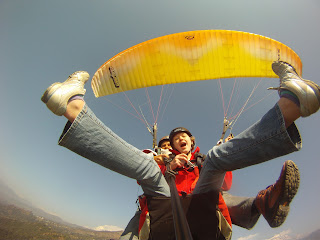We spent a few days over Christmas break in Pokhara...Nepal's 2nd largest city and the starting point for treks through the Annapurna mountain range.
Part of the Annapurna range. Here you can see Annapurna II, II and IV. Several of these peaks are more than 26,000 feet high. Without being there, it's hard to imagine how majestic the peaks truly are.
Our most fun experience by far was paragliding, a first for all of us. Sangarkot (the peak in the foreground) is our jumping off point (literally) for paragliding.
So THIS is how Santa Claus gets all those toys to boys and girls all over the world.
We visit a Tibetan community (Tashi Pakhel). Tibetans first came here after they were expelled from China in 1959. This was one of their original settlements. These Tiebetan refugees are just short of completing a new monastery. The art work is exquisite. Here you see the detail of a painting on the wall. In real life, it's an inch high.
Getting a shave is a cultural experience--one that we want to share with Ben. Here he is getting lathered up. He gets a haircut, along with a head, neck and shoulder massage...all included in the same price. The head massage is brutal and involves heavy clapping and slapping. Somehow in the end, it all feels pretty good.
We spend Christmas morning at Mike's Breakfast, looking over Lake Fewa and listening to Handel's Messiah.
This is a view from the lake. We use a very, very inefficient paddle boat to get to the middle of the lake. But the views are spectacular. Here you see a paraglider above the lake.
Our last day in Pokhara, Betsy and I get up early and take a canoe across Lake Fewa to Chisapani.
We then hike for an hour to this peace monastery. Later, we repeat the hike with Lucie, Eli and Ben.
Each side of the monastery has a statue representing one phase of Buddha's life.
We also hike well beyond the monastery and are rewarded with great views.






















































